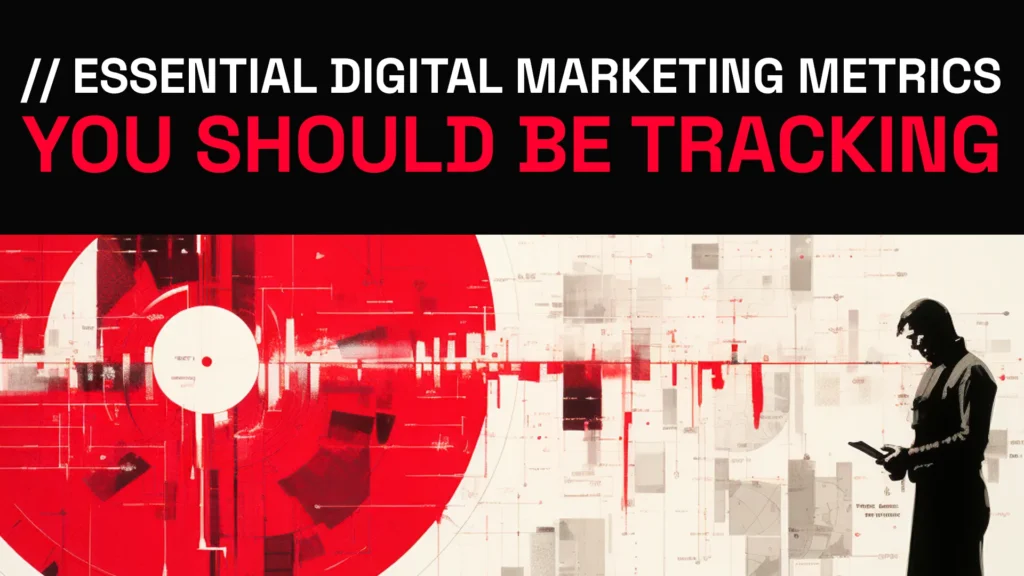
ESSENTIAL DIGITAL MARKETING METRICS YOU SHOULD BE TRACKING
Understanding and Monitoring Key Digital Marketing Metrics
Tracking and analyzing key marketing metrics is essential for marketers and entrepreneurs to gauge their marketing success. These metrics provide actionable insights to refine strategies, boost user engagement, and drive conversions over time.
By closely monitoring key performance indicators, you can determine what’s working and what’s not, informing data-driven decisions to optimize your digital marketing strategy.
This article explores the most pivotal digital marketing metrics to monitor in order to enhance results.
Website Traffic Metrics: Gauging Interest and Engagement
Total Visits – This foundational metric shows the total number of sessions initiated on your website over a given time frame. Tracking visits illuminates the overall reach of your digital presence and interest being driven through marketing campaigns across channels.
Traffic Sources – Pinpointing the originating sources of your web traffic (organic search, paid ads, social media, referrals, etc.) is key for optimizing performance by channel. You can double down on high performing channels while investigating lower performers.
Bounce Rate – The bounce rate denotes the percentage of visitors who enter your site then leave after shortly after without clicking on anything. A high rate often signals irrelevant or unsatisfying landing page content. It could also indicate navigation or site performance issues.
Average Session Duration – The average session duration reveals how long visitors actively engage with your site per visit. Extended time spent signals content that effectively holds user interest, suggesting a high-quality site user experience, while brief durations usually imply less engaging content and a poor user experience.
Monitoring Paid Advertising Effectiveness
Cost Per Click (CPC) – The average amount you pay whenever someone clicks your paid ads. Lower CPC indicates more cost efficient ad spend and targeting relevancy.
Return on Ad Spend (ROAS) – This metric measures the revenue generated for every dollar invested in paid ads. A higher ROAS conveys superior ad results and positive ROI.
Conversion Rate – The percentage of ad clicks that convert into defined goals (email signups, lead form completion, downloads, purchases etc.) This indicates how well your ads and landing pages align with audience interests & wants.
Tracking Website Conversions and Value
Conversion Rate – In the context of a website the conversion rate signifies the percentage of site visitors that complete a desired goal, like making a purchase, downloading content, or signing up for a newsletter. Optimizing this metric is critical for e-commerce brands, as it indicates how well your site converts traffic into customers.
Cost Per Acquisition (CPA) – The average cost to acquire a new customer through your digital marketing channels. A lower CPA signals more cost-efficient and optimized marketing strategies.
Customer Lifetime Value (CLV) – CLV represents the total revenue expected from a single customer relationship over time. This data helps set acquisition budgets and refine retention and upsell tactics.
Gauging SEO Effectiveness
Organic Search Traffic – This volume metric tracks visitors arriving from search engines. Strong organic traffic indicates effective on-page and off-page SEO strategies.
Keyword Rankings – Keyword rankings show where your pages rank in search engine results pages (SERPs) for targeted terms. Higher first page rankings tend to drive more impressions and clicks.
Click-Through Rate (CTR) – SEO CTR is the percentage of searchers who click through to your page after seeing it in a search result. A higher CTR conveys compelling and relevant page titles and descriptions.
Backlink Profile – External sites linking to your pages (backlinks) enhance your website’s authority in the search engines. Quality backlinks can in turn improve search rankings and visibility for targeted keywords.
Benchmarking Social Media Performance
Follower Growth Rate – This metric calculates the speed at which you gain new followers over time on social platforms. Faster growth conveys an effective content strategy and messaging resonance.
Engagement Rate – Your engagement rate quantifies the level of interactions with your social media content, such as likes, shares and comments. Higher rates point to your content being effective and engaging.
Clicks on Posts – Tracking clicks on the links within your social media posts gauges how well your CTAs and messaging drive the desired action. This shows whether your content and offers align with your audience interests.
Key Email Marketing Metrics
Open Rate – This metric reflects the share of recipients opening your emails, indicating not just the effectiveness of subject lines and preheaders but also the impact of send timing, sender reputation, and content relevance. A higher open rate suggests successful email strategies that engage subscribers with timely, relevant messages from a trusted source
Click-Through Rate – Email CTR shows how many recipients clicked on links within your emails. Higher CTRs signal your content and calls-to-action resonate with subscriber interests.
Conversion Rate – This rate denotes the percentage of recipients who completed a desired goal from your email, like downloading content or making a purchase. It quantifies your email marketing’s ability to drive conversions.
Bounce Rate – The bounce rate reflects emails that were unable to be delivered to subscribers due to invalid addresses or other issues. A lower bounce rate conveys subscriber list health and good deliverability.
// CONCLUSION
Tracking key digital marketing metrics provides invaluable insight that informs strategy and drives growth. By monitoring engagement, conversions, and ROI across channels, marketers can make data-driven decisions to optimize activities.
These metrics empower brands to boost engagement, increase conversions, maximize return, and gain a competitive edge.
With so many interconnected components across modern digital marketing, leveraging the right analytics is essential for determining what works, spotting areas for improvement, and prospering both now and in the future.
Carefully tracking these impactful set of metrics allows digital marketers and entrepreneurs to confidently evolve, excel and realize their full potential.


